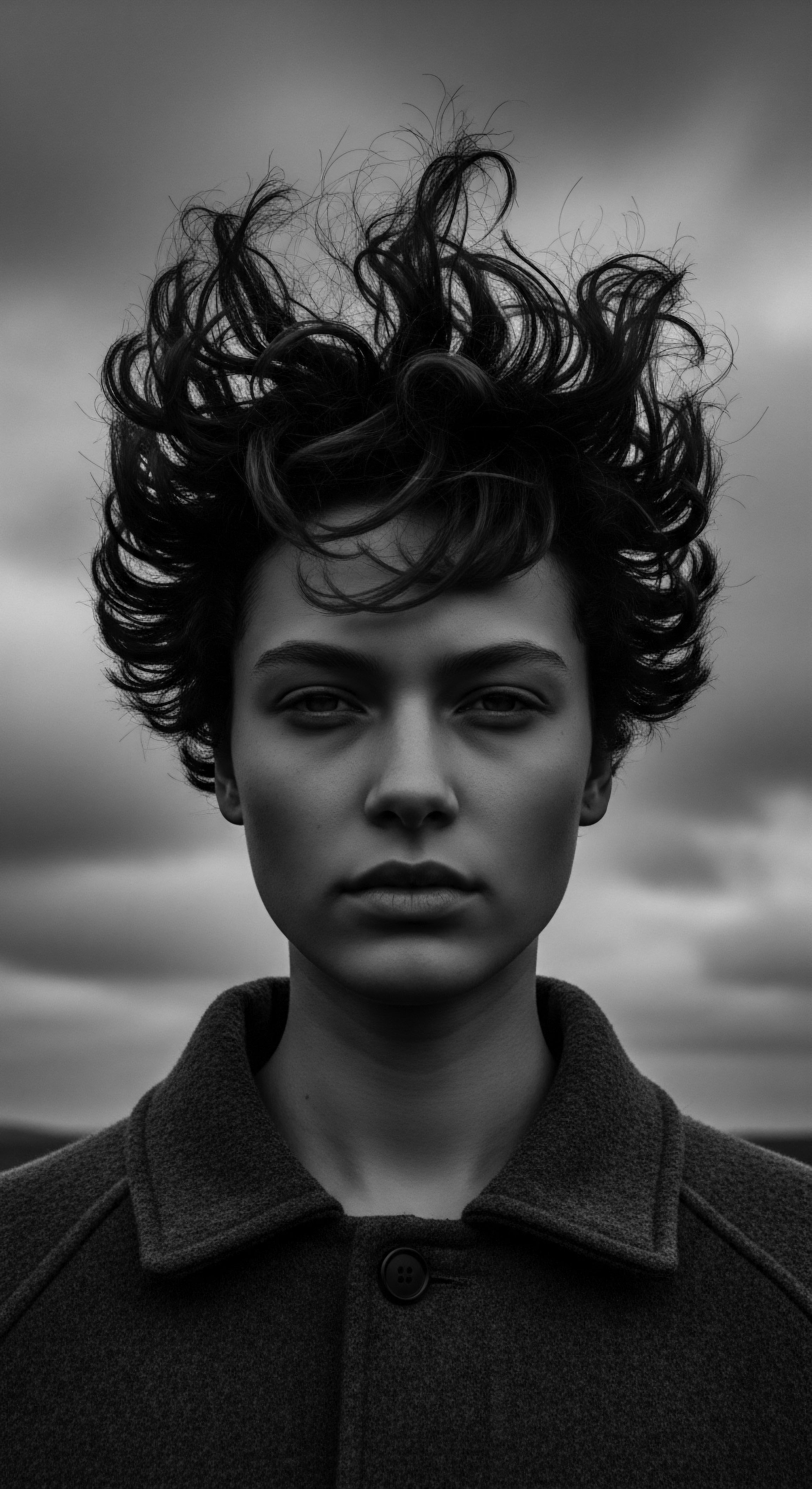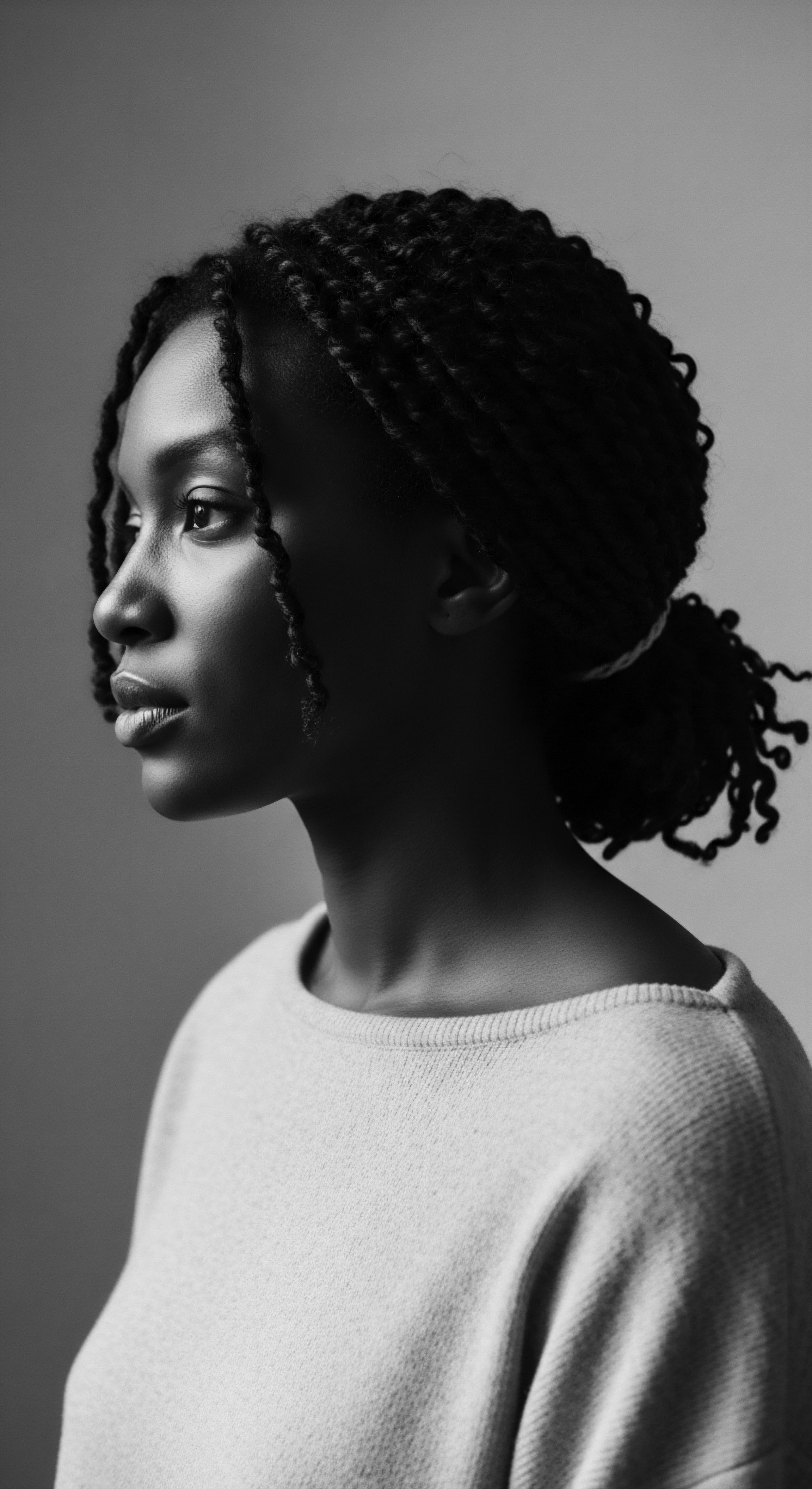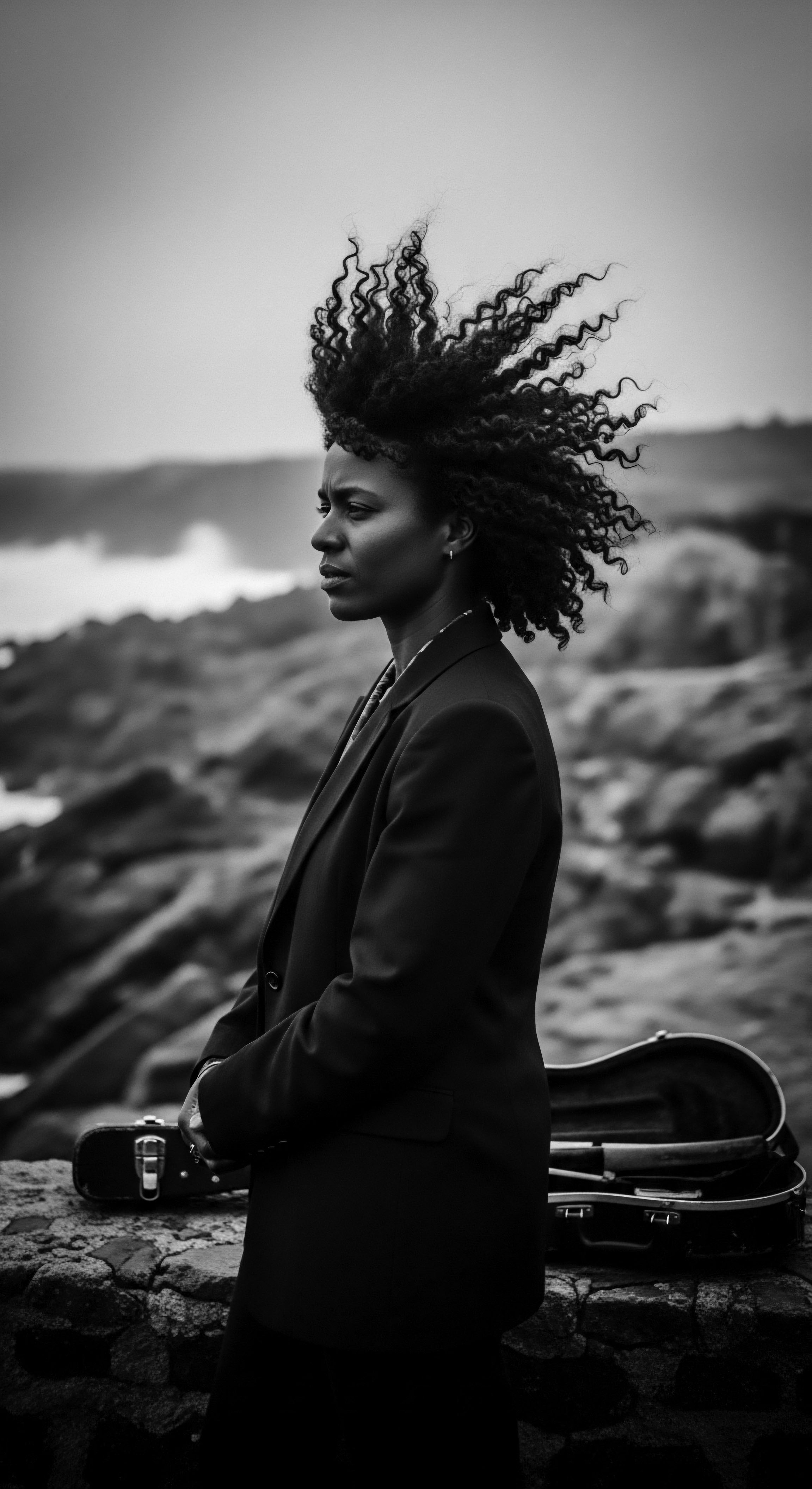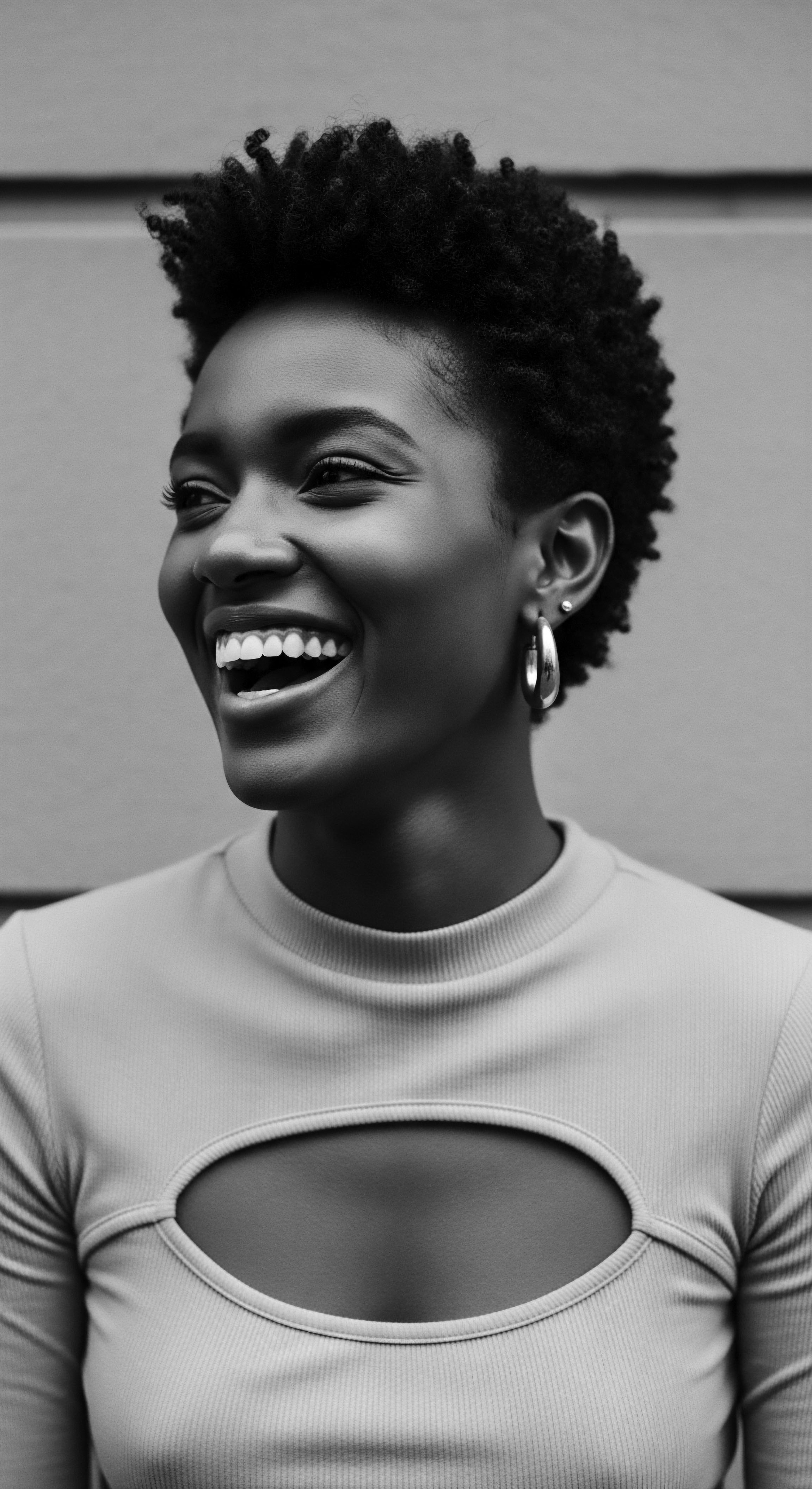
Fundamentals
The intricate world of hair often appears as a simple adornment, yet beneath its surface lies a complex biological architecture, each layer serving a specific, life-sustaining purpose. Central to this architecture, particularly for hair of textured heritage, stands the Lipid Barrier Integrity. At its most elemental, this concept denotes the complete and sound condition of the lipid, or fatty, layers that act as a protective sheath around and within each strand of hair. It speaks to the hair’s inherent ability to shield itself from the world’s relentless offerings—moisture loss, environmental stressors, and the rigors of daily styling.
Consider the hair strand itself, a marvel of natural engineering. It comprises three primary layers ❉ the innermost Medulla, the substantial Cortex, and the outermost Cuticle. The cuticle, often likened to protective scales, is composed of several overlapping cell layers that lie flat when healthy, providing a smooth, reflective surface. Within and upon these layers, lipids reside, forming a delicate yet robust defense.
These lipids are a diverse family of naturally occurring fats, encompassing free fatty acids, cholesterols, and ceramides. Their presence ensures the hair remains supple and resilient.
For textured hair, with its unique helical twists and turns, the integrity of this lipid barrier carries an even deeper significance. The natural curvature of these strands, while offering unparalleled beauty, can create points where the cuticle layers lift, making the hair more vulnerable to moisture evaporation and external forces. A strong lipid barrier mitigates this innate susceptibility, keeping essential moisture within the hair shaft and guarding against dryness, which is a common concern across Black and mixed-race hair experiences. This fundamental understanding is echoed in the collective wisdom of generations past, where ancestral practices often intuitively addressed the need to maintain hair’s protective qualities.
To grasp the foundational nature of Lipid Barrier Integrity, one might think of it as the hair’s natural cloak of resilience. Without this vital protective shield, strands become brittle, easily compromised by the elements, and struggle to retain the very water that keeps them vibrant. The importance of this natural defense cannot be overstated; it is the silent guardian of the hair’s vitality and strength, a foundational element in its ability to flourish.
The Lipid Barrier Integrity defines the sound condition of hair’s protective fatty layers, crucial for safeguarding moisture and resilience in every strand.

Components of the Lipid Barrier
The lipids within hair are not a monolithic entity; rather, they are a symphony of various fatty compounds working in concert. These components are strategically positioned throughout the hair fiber, contributing to its overall health and appearance.
- Free Fatty Acids (FFAs) ❉ These are abundant in the hair, found both internally and on the surface. They contribute significantly to the hair’s natural hydrophobicity, helping to repel water and environmental moisture.
- Cholesterol ❉ An essential lipid component, cholesterol assists in maintaining the structural integrity of the hair’s cell membranes, contributing to the barrier’s cohesion.
- Ceramides ❉ These waxy lipid molecules act as intercellular glue, binding the cuticle cells together and thereby reinforcing the hair’s outermost protective layer.
- 18-Methyleicosanoic Acid (18-MEA) ❉ This unique fatty acid is covalently bound to the outermost layer of the hair cuticle, the epicuticle, providing the primary hydrophobic surface and serving as a critical first line of defense against external damage and water penetration.
The concerted action of these lipids ensures that hair remains protected, reflecting a natural wisdom in its very biological make-up. Understanding these fundamental building blocks allows for a more discerning approach to hair care, one that acknowledges and supports the hair’s inherent protective mechanisms.

Intermediate
Stepping beyond the fundamental definition, a deeper understanding of Lipid Barrier Integrity reveals its intricate role in maintaining the hair’s delicate balance, particularly within the diverse expressions of textured hair. The structural meaning of Lipid Barrier Integrity extends to the sophisticated interplay of lipids within the hair’s cell membrane complex (CMC), a crucial intercellular “glue” that binds together the various cellular components of the hair shaft. This complex, rich in lipids and proteins, ensures the cohesion of the cuticle layers and the cortex, preventing the ingress of damaging substances and the escape of vital moisture.
The significance of this barrier becomes especially pronounced when considering Afro-textured hair. Despite often being characterized by dryness, Afro-textured hair possesses a remarkably high lipid content, indeed, it has the highest overall lipid content, estimated to be 2.5 to 3.2 times higher than European and Asian hair, respectively. However, the distinct biomechanical characteristics of this hair type, notably its unique curvature and spiral follicular growth, introduce points of weakness.
These structural aspects can lead to cuticle lifting and increased susceptibility to breakage, which, in turn, compromises the lipid barrier. This inherent vulnerability underscores the importance of practices that actively support and replenish the lipid layers.
Despite its high lipid content, Afro-textured hair’s unique curvature can leave its lipid barrier vulnerable to moisture loss and damage, necessitating intentional care.

Damage and the Barrier’s Compromise
Various factors, both environmental and intentional, can impair the Lipid Barrier Integrity. Daily exposure to ultraviolet (UV) radiation, for instance, can lead to a decrease in the hair’s lipid content and a reduction in its tensile strength, particularly affecting the cuticle and hair surface. Chemical treatments, such as coloring, bleaching, and relaxing, are well-known culprits in stripping away these essential lipids, leaving the hair porous and susceptible to further damage. Even seemingly benign activities like excessive washing can deplete the hair’s lipids, disrupting its natural protective mechanisms.
The visible consequences of a compromised lipid barrier are familiar to many who tend to textured hair ❉ pronounced dryness, a rough tactile sensation, diminished shine, and increased frizz. When the barrier is weakened, the hair struggles to retain moisture, leading to a perpetual state of dehydration. This lack of internal hydration also translates into reduced elasticity, making the hair more brittle and prone to mechanical damage from combing, styling, or even simple friction. The hair’s natural resilience is fundamentally diminished.

Ancestral Wisdom and Lipid Nourishment
Long before modern science illuminated the precise molecular structure of hair lipids, communities throughout Africa and the diaspora developed sophisticated hair care rituals that intuitively supported what we now understand as Lipid Barrier Integrity. These practices, passed down through generations, were deeply intertwined with cultural identity, social status, and spiritual beliefs. The ingredients used were often sourced directly from the land, reflecting a profound connection to nature and an intimate understanding of its nourishing properties.
Consider the widespread use of natural butters and oils in traditional African hair care. Shea butter, for instance, a staple across West Africa, is rich in fatty acids and vitamins, providing deep nourishment and softening properties. Coconut oil, revered in many parts of the continent, is known for its ability to form a protective coating over the hair shaft, effectively sealing the cuticle and trapping moisture within. These were not merely cosmetic applications; they were foundational to hair health and protection in environments where hair was constantly exposed to arid conditions or strong sunlight.
Such traditional remedies, while lacking a modern scientific glossary, were profoundly effective in their application. They provided external lipids that mimicked the hair’s natural barrier, preventing moisture loss and strengthening the hair against environmental stresses. The ancestral practices highlight a living archive of care, a testament to generations of observation and adaptation that prioritized the longevity and vitality of textured strands.
| Traditional Practice Daily or weekly oiling/buttering |
| Traditional Ingredients Shea butter, Coconut oil, Karkar oil, Castor oil |
| Modern Scientific Interpretation for LBI External lipids replenish surface barrier, reduce friction, and seal moisture into the hair shaft. |
| Traditional Practice Protective styles (braids, twists, bantu knots) |
| Traditional Ingredients Often combined with oils/butters |
| Modern Scientific Interpretation for LBI Minimize exposure to environmental damage and mechanical stress, thereby preserving the existing lipid barrier and preventing breakage. |
| Traditional Practice Herbal rinses/treatments |
| Traditional Ingredients Aloe vera, various plant extracts |
| Modern Scientific Interpretation for LBI May provide soothing properties to the scalp, supporting a healthy environment for hair growth and potentially assisting in moisture retention. |
| Traditional Practice These ancestral practices, though ancient, intuitively aligned with the principles of safeguarding hair's delicate outer layers and internal hydration. |

Academic
From an academic vantage, the Lipid Barrier Integrity represents a sophisticated biophysical concept, detailing the functional and structural coherence of the lipid-rich components within and on the hair fiber. This integrity is fundamentally rooted in the precise arrangement and chemical composition of lipids, which account for 1-9% of the hair’s dry weight, primarily influencing its hydrophobicity, moisture retention, and overall mechanical properties. The meaning of this integrity is not merely a static state but a dynamic equilibrium essential for the hair’s defense against a constant barrage of environmental and chemical challenges.
The hair’s protective lipid strata are predominantly found in the outermost cuticle layer, particularly the epicuticle, and within the cell membrane complex (CMC) that acts as an adhesive between cuticle cells and between the cuticle and cortex. The epicuticle, the outermost membrane of the cuticle cell, is adorned with a covalently bound lipid monolayer, primarily composed of 18-Methyleicosanoic Acid (18-MEA). This 18-MEA layer confers significant hydrophobicity to the hair surface, acting as the primary barrier against water absorption and chemical penetration.
Its integrity is critical for maintaining hair’s shine and smoothness. Once damaged, 18-MEA cannot regenerate, underscoring the vulnerability of this external lipid defense.
Beneath the epicuticle, within the CMC, other endogenous lipids—including free fatty acids, ceramides, cholesterol, and glucosylceramides—provide structural support and influence the hair’s internal moisture balance. These lipids contribute to the cohesive forces that hold the hair’s cellular structures together, impacting its flexibility and resistance to breakage. A loss of these internal lipids can significantly decrease hair hydration, affecting its resilience.
At an academic level, Lipid Barrier Integrity signifies the precise structural and chemical order of hair’s lipid layers, paramount for its functional protection and moisture retention.

Textured Hair ❉ A Unique Lipid Profile and Its Implications
Research into hair morphology across different ethnic groups reveals distinct lipid profiles and structural characteristics that profoundly influence Lipid Barrier Integrity. Afro-textured hair, for instance, exhibits the highest overall lipid content among various hair types, containing quantities estimated to be 2.5 and 3.2 times higher than European and Asian hair, respectively. Moreover, the internal lipid content of Afro-textured hair is reported to be 1.7 times higher than that of the other two ethnic groups. This abundance of lipids, particularly apolar lipids, contributes to Afro-textured hair’s lower radial swelling percentage in water.
Despite this inherent richness in lipids, Afro-textured hair is frequently characterized by a perception of dryness and increased susceptibility to breakage. This seeming paradox is understood by considering the unique biomechanical properties of highly curved hair fibers. The elliptical cross-section and numerous twists and turns in Afro-textured hair create natural points of weakness and areas where the cuticle layers can lift more readily.
These structural intricacies render the lipid barrier more prone to mechanical disruption and environmental challenges, leading to accelerated moisture loss and greater fragility. This understanding emphasizes that while lipids are plentiful, their organization and the unique physical demands on textured hair necessitate targeted care strategies to maintain the barrier’s efficacy.

The Enduring Efficacy of Chebe Powder ❉ An Ancestral Approach to Lipid Barrier Preservation
The ancestral hair traditions of various African communities offer compelling, empirically validated examples of how practices, developed over centuries, intrinsically supported Lipid Barrier Integrity. Among these, the ritualistic use of Chebe Powder by the Basara Arab women of Chad stands as a particularly profound illustration of a heritage-rooted practice directly impacting hair’s protective layers. These nomadic women are renowned for their exceptionally long, thick, and healthy hair, often extending past their waist, a testament to generations of consistent application of this traditional remedy.
Chebe powder, a natural concoction made from roasted and ground ingredients such as Croton zambesicus seeds, Mahllaba Soubiane (cherry kernels), cloves, resin, and stone scent, does not directly stimulate hair growth from the scalp. Its true power, and its connection to Lipid Barrier Integrity, lies in its remarkable ability to reduce breakage and enhance length retention by effectively sealing in moisture and strengthening the hair shaft. The traditional method involves mixing the powder with oils or butters—such as karkar oil, a blend of sesame oil and animal fat—and applying this paste to damp, sectioned hair, which is then braided and left for days. This continuous coating acts as a physical barrier, protecting the hair strands from friction, environmental exposure, and excessive moisture loss.
The oils and butters mixed with the Chebe powder provide external lipids that supplement and reinforce the hair’s natural lipid barrier. By physically sealing the cuticle and maintaining a consistently moisturized environment around the hair shaft, this traditional practice effectively mitigates the very issues—dryness and breakage—that textured hair, despite its high inherent lipid content, can encounter due to its structural characteristics. This continuous hydration and external protection offered by the Chebe ritual underscore a sophisticated, ancestrally developed understanding of hair preservation. The ritual protects the hair’s delicate outer scales from environmental aggressors and mechanical stress, allowing the hair to retain its native moisture and thereby preserving the integrity of its existing lipid structures over extended periods.
The wisdom embedded in the Chebe ritual demonstrates a long-standing, community-based solution to maintaining hair health. It provides a powerful example of how deep cultural practices can align with and offer practical applications for complex biological concepts such as Lipid Barrier Integrity. The consistent application of the Chebe mixture creates a protective milieu, allowing the hair to flourish, defying the challenges posed by its unique morphology and the surrounding environment. This ancestral practice offers a powerful counter-narrative to the common perception of textured hair as inherently “dry,” instead highlighting a legacy of ingenious solutions for moisture preservation and length retention.
Chebe powder, when blended with oils and applied traditionally, creates a protective shield, preserving hair’s moisture and strengthening its natural lipid barrier against environmental wear.

Scientific Mechanisms of Traditional Lipid-Supporting Ingredients
The effectiveness of traditional ingredients in preserving Lipid Barrier Integrity can be understood through their biophysical and biochemical properties. Many natural oils and butters possess compositions that complement hair’s intrinsic lipids.
- Coconut Oil ❉ Rich in lauric acid, a medium-chain fatty acid. Its small molecular size allows it to penetrate the hair shaft, reducing protein loss and helping to form a film on the hair surface, sealing the cuticle and preventing moisture escape. This action directly supports the hair’s external lipid barrier.
- Shea Butter ❉ Composed of various fatty acids like oleic and stearic acids. It provides occlusive properties, creating a protective layer that minimizes transepidermal water loss from the hair, maintaining hydration and contributing to the integrity of the hair’s outer layers.
- Castor Oil ❉ Contains ricinoleic acid, a unique fatty acid with moisturizing qualities. Its viscosity allows it to coat the hair effectively, offering a barrier against environmental damage and helping to reduce split ends by smoothing the cuticle.
- Argan Oil ❉ Abundant in essential fatty acids and Vitamin E. It aids in nourishing the scalp and hair, reducing frizz and promoting shine, indirectly supporting the lipid barrier by conditioning the hair fiber and reducing susceptibility to mechanical damage.
These traditional applications exemplify how indigenous knowledge, developed through empirical observation and intergenerational transmission, aligns with modern scientific insights into hair lipid function. The consistent use of these natural emollients and sealants demonstrates a deeply ingrained understanding of how to maintain the hair’s protective mechanisms, allowing textured hair to achieve its full potential in length and vitality. The heritage of these practices speaks to a profound respect for the hair’s inherent structure and its capacity for resilience when appropriately nurtured.

Reflection on the Heritage of Lipid Barrier Integrity
The journey through the intricate understanding of Lipid Barrier Integrity, from its elemental biological definition to its profound cultural resonance, reveals a continuous and unbroken thread of wisdom. This thread binds us not just to scientific understanding, but to the ancestral hands that first intuited the hair’s need for protection and sustenance. The notion of Lipid Barrier Integrity, at its heart, is a reaffirmation of the deep care embedded within textured hair traditions across the African diaspora. It stands as a testament to the ingenious ways communities preserved the vitality of their strands, often against odds of forced assimilation or environmental harshness.
Each twist, each curl, each coil carries the echoes of countless generations who understood, without a formal scientific lexicon, that hair required a shield, a sealant, a profound ritual of anointing. The practices of oiling, buttering, and protective styling were not merely cosmetic choices; they were acts of preservation, affirmations of identity, and quiet declarations of resilience. They were, in essence, the applied science of Lipid Barrier Integrity, a living embodiment of heritage. The enduring presence of these rituals, now often validated by contemporary research, reminds us that the wisdom of the past is not merely historical artifact; it is a dynamic, living wellspring of knowledge, guiding our hands in the present.
As we look towards the horizon, this expanded understanding of Lipid Barrier Integrity, particularly within the context of Black and mixed-race hair, empowers us to approach hair care with renewed reverence. It beckons us to honor the legacy of those who came before, to recognize the profound connection between hair health and holistic well-being, and to continue to adapt and innovate with respect for our roots. The integrity of our hair’s lipid barrier mirrors the integrity of our cultural heritage ❉ it is a layer of protection, a source of strength, and a vibrant expression of who we are, extending from ancient hearths into the unbound future. This collective understanding, born from ancestral wisdom and illuminated by modern inquiry, invites each of us to nurture our hair not just as strands, but as living archives of history, beauty, and enduring spirit.

References
- Byrd, A. D. & Tharps, L. (2014). Hair Story ❉ Untangling the Roots of Black Hair in America. St. Martin’s Press.
- De Canha, M. N. et al. (2020). Book review ❉ Herbal principles in cosmetics ❉ Properties and mechanisms of action. Frontiers in Pharmacology, 10, 1513.
- Decker, C. & Maibach, H. (2009). Hair Care ❉ An Illustrated Dermatologic Handbook. Springer Science & Business Media.
- Halal, J. (2009). Hair Structure and Chemistry Simplified. Milady.
- Lin, T. K. Zhong, L. & Santiago, J. L. (2017). Anti-inflammatory and skin barrier repair effects of topical application of some plant oils. International Journal of Molecular Sciences, 19(1), E70.
- Mangum, S. & Woods, S. (2011). Black Hair Care. Journal of Counseling and Development, 89(1), 81-89.
- Mbilishaka, T. (2018). PsychoHairapy ❉ A Stylist’s Guide to Holistic Black Hair Care.
- Rele, A. S. & Mohile, R. B. (2003). Effect of mineral oil, sunflower oil, and coconut oil on prevention of hair damage. Journal of Cosmetic Science, 54(2), 175-192.
- Robbins, C. R. (2012). Chemical and Physical Behavior of Human Hair (5th ed.). Springer Science & Business Media.
- Sarkar, R. et al. (2017). Use of vegetable oils in dermatology ❉ An overview. International Journal of Dermatology, 56(10), 1080-1086.
